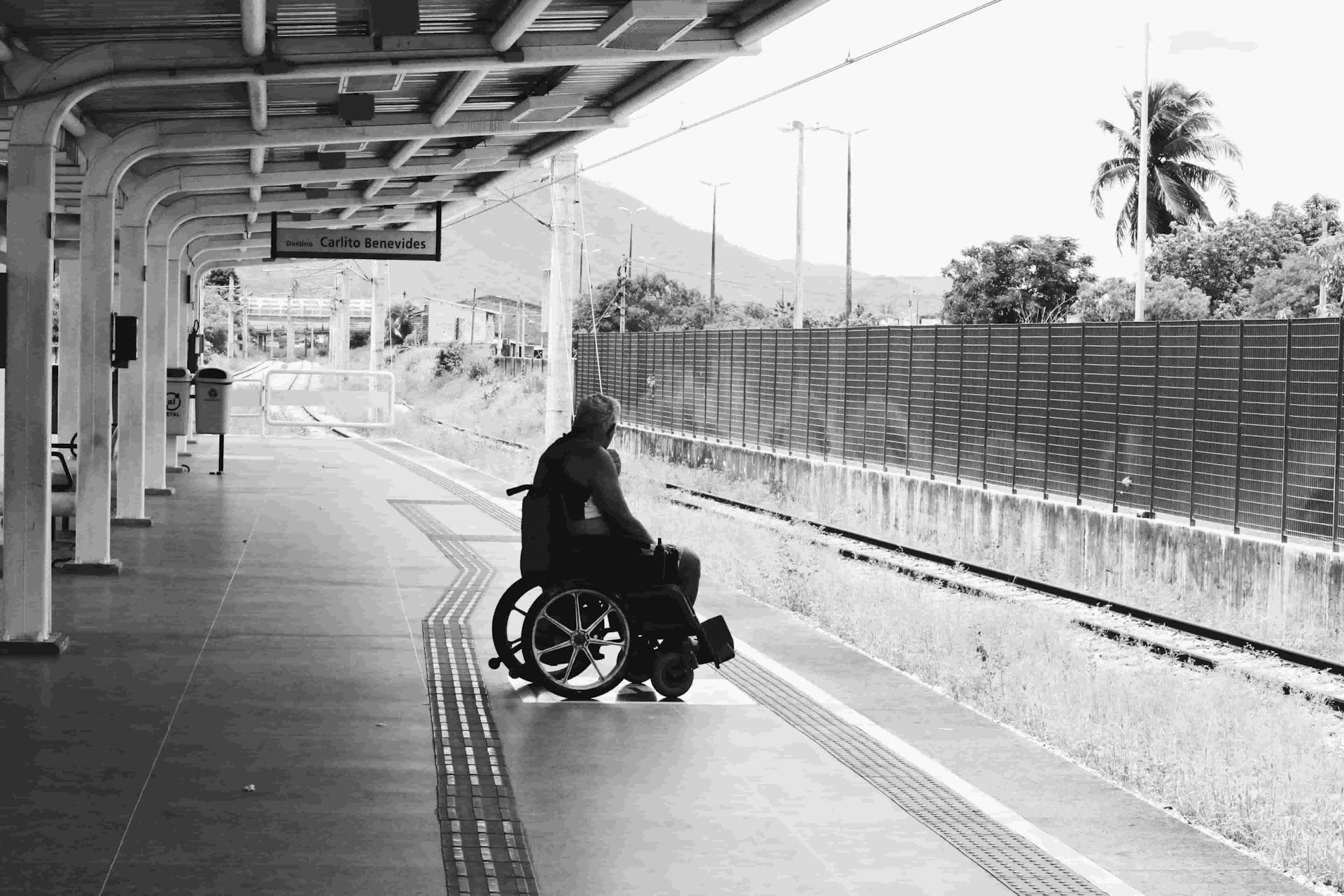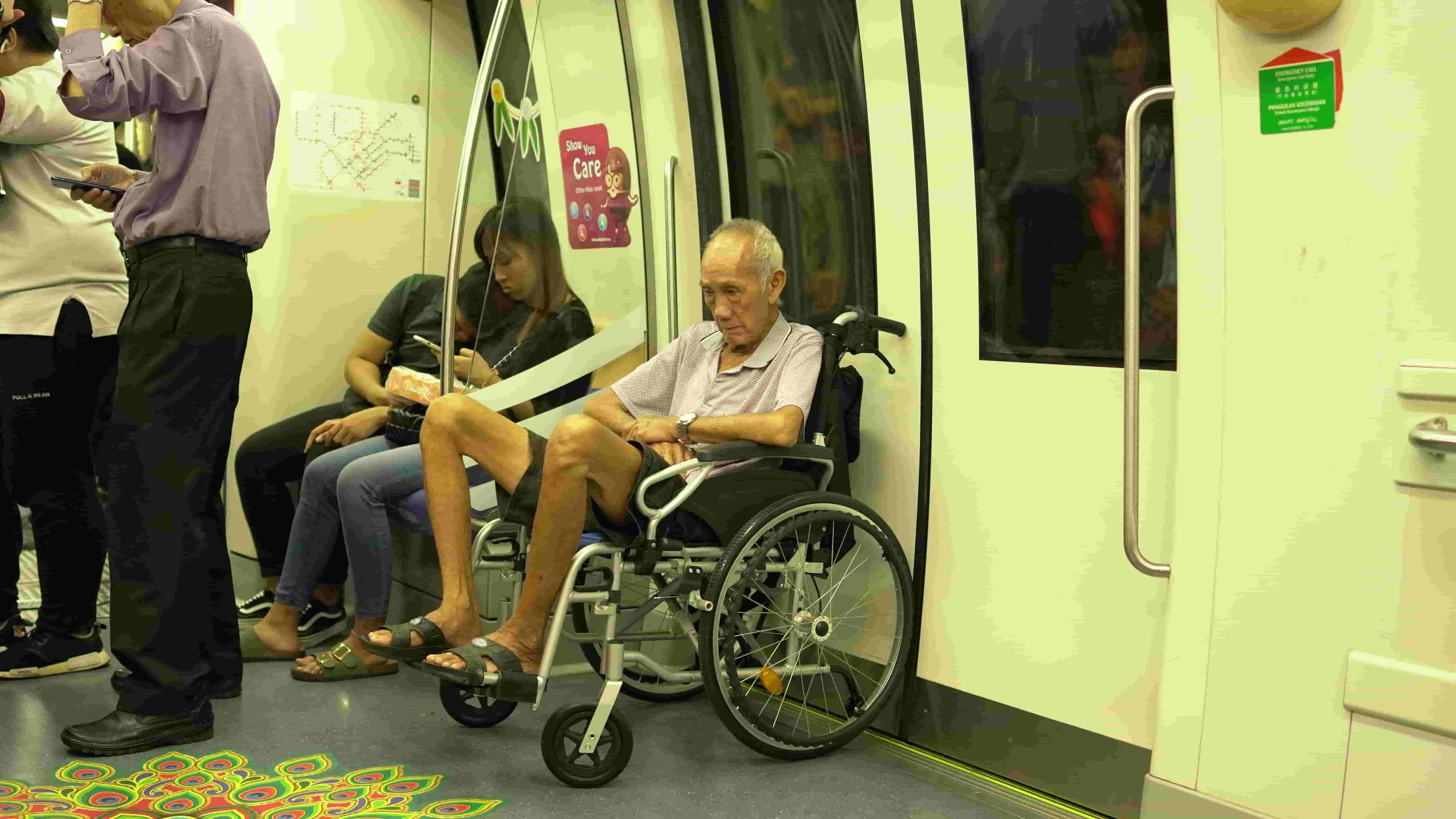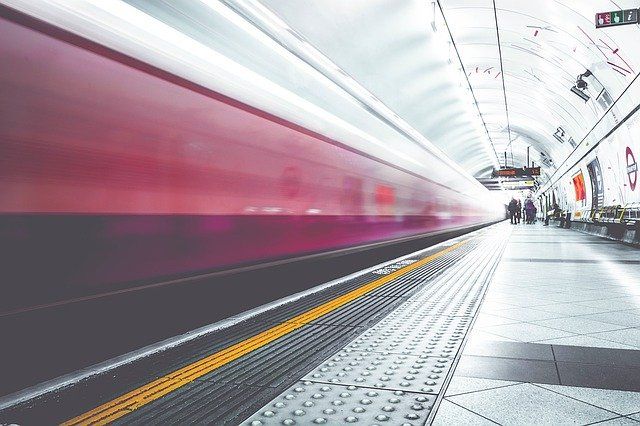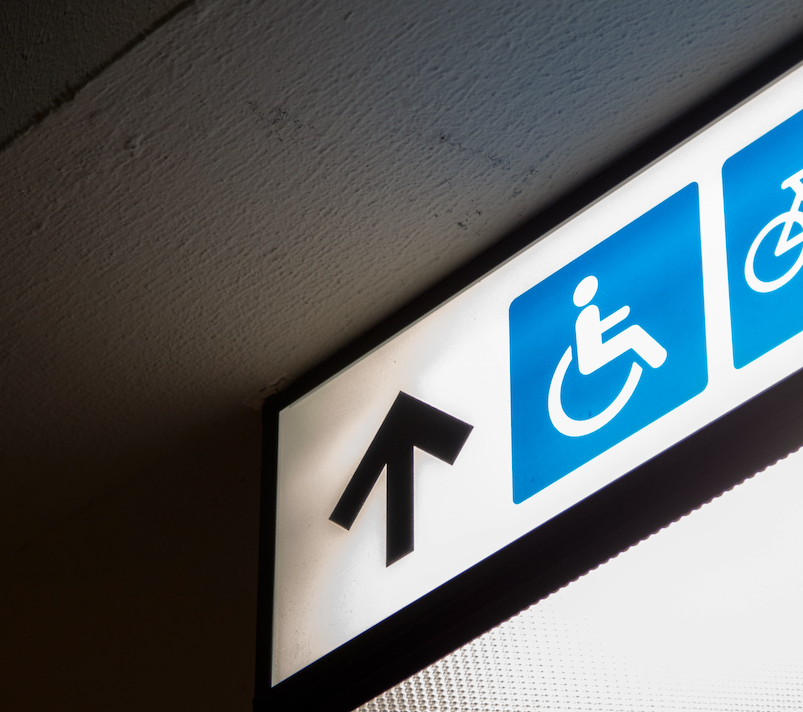Does Britain Have a Transport Accessibility Problem?
updated on Mar 17, 2020

Accessing public transport should be simple, shouldn’t it? Yet thousands face delays, inequalities in access, a lack of support and understanding. Enough is enough
Whether we’re talking about your daily commute or venturing further afield, it’s hard to deny: travel can be stressful at the best of times. Overcrowding, cancelled services, last-minute platform changes, traffic jams – no matter what form of transport you opt for, there’s always something that can turn a straight-forward journey into something that leaves us feeling anxious, frustrated, or exhausted.
But what about for those who have other challenges to take into consideration? According to research, one in four disabled people don’t use public transport thanks to negative attitudes from other passengers. Two in five (40%) people with physical or hidden disabilities frequently experience difficulties when travelling by train.
Long waits at stations, a lack of staff to provide assistance, accessibility, and usability of facilities available can all provide hurdles that can cause anxiety, frustration, and a knockback in confidence for individuals who are just trying to use public transport.

According to Scope, there are nearly 14 million disabled people in the UK. How have we not made public transport more accessible for everyone? Why is disabled people’s access to the same services and spaces often still an afterthought, rather than a priority?
Does British transport have an accessibility problem?
Transport for All Campaigns and Community Coordinator, Katie Pennick, shared her personal experience and frustration with public transport in a series of tweets that went viral in early 2020.
I’m watching my train leave in 5 mins and I’m not on it because I apparently didn’t arrive early enough for staff to get the ramp.
— Katie Pennick👩🏼🦽 (@KatiePennick) January 22, 2020
I’m late because the bus I was on let everyone (20+ people -full bus) off before deploying the ramp for me.
Everyone on that bus made their train. pic.twitter.com/BVsSGI4qrR
Despite arriving before her train was due to leave, Katie had to watch it leave as she wasn’t ‘early enough for staff to get the ramp’. Her delay was due to a bus driver who chose to allow all other passengers off of the bus before they would deploy the ramp for Katie.
As Katie went on to explain, small delays can have a knock-on, accumulative effects for those who experience them. A lack of general understanding by the public can also add to the frustration felt by the individuals. Unsympathetic comments flooded in questioning why she couldn’t get an earlier bus, and defending the drivers choice to allow other passengers out first. Others questioned why ramps aren’t deployed for every train.
Katie has since shared further experiences she has had on trains, which has seen the rubbish taken off of the train before assistance was provided for her to leave. In an unrelated tweet, Dr Amy Kavanagh explained the ongoing toll day-to-day barriers can have for those with disabilities.
It’s not just the active discrimination like the service refusals, it’s the daily grind of a world full of barriers & exclusions.
— Dr Amy Kavanagh👩🏼🦯 (@BlondeHistorian) February 5, 2020
It’s the forced smile & putting up with the excuses, the “oh sorry we forgot” & the exhaustion of planning & constantly finding coping mechanisms.
A recent travel experiment across Transport for London (TfL) revealed that there needs to be more consideration of what it means to live and travel with a disability, as a ‘one size fits all’ approach is rarely helpful for all. Specialist solicitors Bolt Burdon Kemp conducted a travel experiment across London’s busiest commute routes to reveal just how hard it is to navigate the country’s busiest transport system.
With 1.3 of the estimated 5.5 million journeys made in London each day thought to be by those with disabilities, just over a quarter (77) of the 270 stations are fully accessible for wheelchair users. Despite being the 11th busiest metro system in the world, passengers with physical disabilities cannot fully access a huge proportion of London’s transport system. The ‘Going the Extra Mile’ experiment sought to see how accurate public transport times (and facilities listed) were, as well as to raise awareness of accessibility issues on public transport.
Enlisting the help of five wheelchair users across five of London’s most popular commuter journeys, the study saw able-bodied commuters and wheelchair users start their journey from the same point at the same time, with the same finishing destination.

Of the journeys completed, the limited options for those with disabilities – often resulting in more challenging, longer journeys – were highlighted. The five commuter journeys took over a combined three hours five minutes longer to complete than journeys made by able-bodied passengers – making for a 49% longer travel time.
What is just a nine-minute commute from Liverpool Street to Kings Cross for an able-bodied passenger took 32 minutes for a wheelchair user, whose only option was a single bus route. Another popular route, Wembley Park to Westminster, took 83% longer than advertised via the ‘step-free access’ option on the Transport for London journey planner. Jennifer, the wheelchair user who tested this part of the journey, avoids public transport in her day-to-day life. When speaking about her experience, she said “Today was the first time I’d used public transport since getting injured. I probably wouldn’t use it again.”
Karl, another participant, lives close to five underground stations, yet is limited to using busses for the majority (90%) of his travel. “Buses are unpredictable, so it can get really difficult.” Making the journey from Victoria to Oxford Circus takes just four minutes for an able-bodied passenger, but for Karl, the journey took 73% longer due to the bus route he had to use instead.
A lack of facilities and lengthier bus routes aren’t the only problems faced by differently-abled passengers looking to travel in the country’s capital. It was revealed that planning a journey itself can be a recurrent problem.
So much of disabled life is about planning. We can’t jump on a train, book a last minute hotel or try a new restaurant. Planning becomes habit, it takes over our lives. The hardest thing is to be mindful, to live in the moment when everything has to be researched and scheduled.
— Carrie-Ann Lightley👩🏼🦽 (@CarrieALightley) February 17, 2020
Due to unreliable and inaccurate information, many cross-check multiple apps to try and get a clearer picture of the route they should take. One participant revealed “I use Google Maps’ satellite function to determine the state of the pavement I’d need to take” as unforeseen obstacles can cause frustration and delays. “If the bus stops at an awkward place, it can be a struggle wheeling up.”
Official apps and tools are also failing users. For the participant taking the Westminster bound journey, the TfL journey planner suggested changing at Finchley Road for the Jubilee line – a similar journey that able-bodied passengers would take. Yet in reality, staff at the starting point of the journey advised this wasn’t possible, as the gap would be far too large for an electric wheelchair. While the route would have worked for a manual wheelchair user, it had the potential to leave electronic wheelchair users stranded.
Unforeseen challenges
As part of the Going the Extra Mile experiment, it was revealed that despite careful planning, many still face regular, unforeseen obstacles and challenges. Some of the most common included:
Transport staff who are unprepared to offer assistance
One participant was left waiting on a bus as it arrived at King’s Cross Station. The driver closed the doors before she could exit using the ramp. She revealed that some bus drivers have difficulty in activating the ramp. “It sounds ridiculous, but sometimes the driver might even ask me for guidance on how to activate it!”

No staff available
On her Westminster bound journey, Jennifer faced an unexpected challenge: there were no staff present to assist with setting up a ramp at her destination, despite assurance from the information point that this had already been arranged for her. This resulted in her having to rely on help from a stranger to exit and navigate the station.
Difficult transfers
For another participant, getting to the London Bridge bus station from the London Bridge underground station proved to have an unexpected hurdle: an uphill journey. “I’m a very active wheelchair user, but even I was tempted to stop for a minute to catch my breath.”
How does London compare?
While unexpected challenges can prove frustrating, how does London compare to other European cities when it comes to accessibility? As part of Going the Extra Mile, wheelchair user Sarah gave insight into her own experiences at home and abroad.
“The transport systems in other countries are much better. In London, you have to rely on staff to call in to stations to arrange ramps for you, and this can take at least 10-15 minutes. But in Milan, Berlin and New York, you’re so relaxed! All you have to do is get on the carriage behind the driver and you know they’ll be there to help you get on or off. It’s much more streamlined.
“If I’m in the middle of a journey in London and find my destination station is closed that day, or that the lifts aren’t working, it can be very difficult to re-plan the journey because so many stations are still not accessible. So much needs to be done in London to make commuting easier for people like me.”

Everyday challenges: what would you like to see change?
We asked the disabled community what challenges they face when travelling within the UK. Postgrad student Rachel Davies shared her biggest worries.
“What I worry about in travelling is whether staff and other passengers will understand what extra help I need. Will the support be reliable if I book assistance? What if they forget about me? Would my luggage be left behind if nobody helped me?” Rachel went on to reveal that due to her worries, she has avoided travelling alone, which can limit the opportunities available to her.
“I’ve turned down training opportunities that would be really useful to my career because the idea of travelling alone on public transport outside of my local area is just too stressful.”
When asked what she would like to see change, Rachel explained that fellow passengers and staff could make a significant impact. Expanding the ‘Please offer me a seat’ scheme to a wider range of locations could also have a positive effect.
Stumbled across this when researching something else. It’s a great idea. Despite what the website says you can order a pack from any part of the country. Would love to see @Cardiffbus @StagecoachWales and @tfwrail team up to do something similar in South Wales. #AccessibleTravel pic.twitter.com/JGDgIbbyLp
— Rachel Davies (@RachelDavies_) January 17, 2020
“One of the things I’m very conscious of as a disabled person is burdening other people. I’ve got a balance disorder, so having to stand on a bus or train would be really difficult for me. I don’t want to ask people to give up their seat, but it’s stressful to wait for an offer. That badge helps people to offer more easily.
“I’d like passengers and staff to be less afraid of offering help. I think sometimes there’s a fear that the offer will be insulting. But even if the help is declined, the gesture will always be appreciated. Simply asking someone if they would like a seat makes a massive difference.”
Many disabled passengers face not just physical barriers but human ones too. @KatiePennick is a wheelchair user and campaigner for @Transport ForAll. She was told there was no ramp, no space and no way she could board a train home from Marylebone. @RagsMartel reports. pic.twitter.com/DYHrbgySMr
— ITV London (@itvlondon) February 24, 2020
Deaf journalist and campaigner, Liam O’Dell, thinks the UK has an accessibility problem.
“Public transport absolutely has an accessibility problem, and is letting disabled people in this country down. In my case, I’m mildly deaf, which means I can struggle to hear certain conversations, and when I’m not wearing my hearing aids, I struggle to understand volumes and can ask for things to be repeated a whole lot more.
“My biggest frustration at the moment with train services is the lack of information in times of disruption. I rely on the screen displays on a train to tell me about the next destination, but when these are turned off or faulty, I have to rely on the platform signs outside the window, which isn’t always easy when I'm travelling home on a dark winter night.”
With frequent disruptions to service, railworks, and cancelled services our railways are known for, Liam explains the additional problems he faces when things do not go to plan.
“It gets a lot worse in times of disruption. Megaphones are not accessible for me, yet there’s been a few times now where station staff shouts information down a megaphone to a scrum of passengers. As I’m often nowhere near the front, I can’t hear anything at all as my hearing loss tends to get worse with distance.
“If this was the first time it’s happened, I’d be alarmed and panicked. I still am now whenever it happens, especially as I could end up trapped in another part of the country with no way to get home, but there’s now a sense of feeling desensitised to it all because it happens so often.
This sense of communication breakdown is faced by all disabled people on public transport, regardless of the specific type of disability a person has
“This sense of communication breakdown is faced by all disabled people on public transport, regardless of the specific type of disability a person has. I’m left confused and distressed by inaccessible information about train delays, whilst wheelchair users are left stranded on train platforms because ramps have not been sorted out by station staff. Disabled people are simply being failed by the rail system and it is unacceptable.”
We asked Liam what he feels other passengers could do to be more mindful and help each other when using public transport.
“I suppose it’s just a greater sense of awareness of other passenger’s needs. I’ve heard of instances where fellow passengers have stopped train doors from closing until wheelchair users can be provided with the ramp needed to get off the train, for example. More non-disabled people speaking out in times of poor access would be great.”

Making transport more inclusive for all
Scope, the charity for quality for disabled people, offers advice and guidance to help make different forms of transport (and planning) more accessible and less stressful. Finding accessible ways to travel – whether that’s on a regular commute, when travelling for fun, or going on holiday – can help individuals to feel more confident about travelling on their own.
Planning is key – but isn’t always possible. Find out how to prepare for last-minute journeys, how you can get the latest updates on any changes that may affect your journey, and everything you need to know about train assistance (including what to do if it doesn’t turn up).
Scope also offers tips for finding accessible transport. From useful websites and apps, to knowing your rights when it comes to using transport – as well as what to do if something goes wrong – Scope also advises on how you can make the cost of travel and transport more accessible.
The sunflower lanyard scheme has become more popular over recent years. Designed to help those with hidden disabilities or health conditions know that they may need additional help or assistance during their journey, the lanyards (available free of charge at many airports, by post, or in Tesco stores across the country) have become more prominent across airports and railways within the UK.
Passengers with hidden disabilities who wish to travel independently at the airport will have the option of wearing a sunflower lanyard, recognised by our staff to provide the passenger with any help that may be required at various stages of the journey. 🌻https://t.co/W8u9Ob7cac pic.twitter.com/9gF67b89F5
— Heathrow Airport (@HeathrowAirport) February 18, 2018
Disability Rights UK have created a guide written by and for those with a disability or health condition. ‘Doing Transport Differently’ offers advice and information on how you can access public transport, the benefits it can offer, how to use the different kinds of transport available, and what you can do if something goes wrong. Find out more about Disability Rights UK, the work they are doing, and how you can offer your help and support to the charity.
What can I do to help?
If you think that the inaccessibility and inequalities in public transport need to change, you can join Scope’s campaign for fair travel. Calling for the government and public transport companies to be clearer about the services that disabled people should be able to expect, Scope aren’t asking for perfection – just equality and fairness.
Transport for All is a London-based organisation of disabled and older people dedicated to championing the rights of disabled and older people to travel with freedom and independence in London. Offering an advice link to help disabled and elderly Londoners know their travel options and rights, Transport for All offers free, impartial, experience-based advice. Find out more about how you can get in contact, offer your support by becoming a member, or donate to help keep the charity running.
What I want non-disabled people to understand is how utterly humiliating it is when your access needs aren’t met.
— Dr Amy Kavanagh👩🏼🦯 (@BlondeHistorian) February 5, 2020
It’s not your fault but suddenly your needs feel so awkward & shameful.
The embarrassment of being excluded is painful, especially when there is no solution.
We all have a responsibility to speak out when we see that something isn’t right or fair – as well as the responsibility to educate ourselves on the issues and challenges around us. It’s imperative that we treat everyone with the same level of respect and understanding that we ourselves would like to be treated with. No matter how good your intentions may be, remember to always respect others boundaries, ask before helping, and avoid making assumptions.
While changes are being made to help make things more accessible for all, progress can be slow-going. For those facing challenges here and now, the promise of future change can be frustrating. Not having a working solution – even a flawed one – isn’t fair, yet it’s something disabled people face each day when small adjustments that take minutes out of our day, but are essential for others to safely access public spaces, aren’t made.
Equal access to public transport should be a basic, fundamental right. It’s time we ask ourselves: why isn’t it yet?

